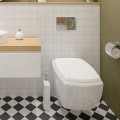When it comes to making sure the electrical wiring in your bathroom is up to code and secure, the National Electric Code (NEC) provides general guidelines. However, it's essential to remember that local codes always take precedence over the national code. Every bathroom must have electrical wiring and capacity for at least one light and an exhaust fan, which is used to ventilate the area. This circuit must be a 20 amp circuit to suit both functions.
Newer luminaires are equipped with wiring that can withstand temperatures of up to 90 degrees, but the wiring of older luminaires was designed to withstand 60 degrees. If your home was built before 1987, check the wiring for a date stamped on the insulation cover. Cables manufactured after 1987 must have a date, while cables manufactured before 1987 will not. The old wiring will need to be replaced.When remodeling your bathroom, there are certain electrical requirements you'll need to follow.
Most communities require that bathrooms have a window that can be opened or an electric ventilation fan that draws moisture from the bathroom to the outside. The NEC suggests that bathroom circuits should be dedicated to the bathroom and not serve other rooms, but your local jurisdiction may allow this, so check with local building inspections about this.The latest code establishes requirements for major new construction or remodeling work in which the surface of the bathroom is being expanded. It's important to adhere to these requirements in order to ensure your bathroom is safe and up to code.When it comes to electrical wiring in your bathroom, it's important to make sure you're following all of the necessary codes and regulations. This includes checking for any outdated wiring and making sure you have adequate ventilation.
Additionally, if you're doing any major remodeling work, you'll need to adhere to the latest code requirements. By following these guidelines, you can ensure your bathroom is up to code and safe for use.




Leave a Comment